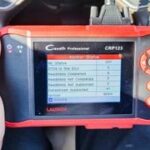Modern vehicles are significantly more complex than their predecessors, boasting ten times more control units than cars from the 1990s. This technological leap means a greater capacity for self-diagnosis, often indicated through error codes. This is where the utility of on-board diagnostics (OBD2) scanners becomes apparent.
Learning how to effectively use an OBD2 scanner can lead to considerable savings in both time and money. For the average car owner, understanding the basics of these devices is invaluable.
Understanding OBD2 Scanner Uses
An OBD2 scanner is a vital instrument designed to interface with your car’s computer system via a designated port, extracting a wealth of information from its various control units. Obd2 Scanner Uses include retrieving fault codes, which signal potential issues, and accessing live data streams, encompassing real-time readings of pressure, temperature, and speed.
This data originates from an array of sensors distributed throughout the vehicle. Typically, fault codes are triggered when a sensor reading falls outside of acceptable parameters or when a sensor ceases to communicate effectively.
More sophisticated diagnostic tools expand on these capabilities, offering servicing functions and even coding options. Coding becomes essential when replacing specific electronic components in contemporary vehicles, ensuring seamless integration and operation.
On-board diagnostic systems compliant with OBD2 standards became mandatory for all cars manufactured from 1996 onwards in the United States and from 2004 in Europe, reflecting their importance in vehicle maintenance and diagnostics.
Exploring Different OBD2 Scanner Types and Their Uses
The market presents a wide array of OBD2 scanners, each catering to different needs and budgets. The most accessible and budget-friendly option is a Bluetooth OBD2 code reader. These compact devices pair with smartphones, typically via an app, and are capable of reading fault codes and displaying basic live data. For everyday drivers, these offer a convenient entry point into vehicle diagnostics.
For individuals who are inclined towards DIY car repairs, investing in a more advanced OBD2 scanner is advisable. Beyond basic code reading, these scanners often provide the functionality to reset service reminders, initiate service procedures necessary for tasks like brake pad replacement, and access a broader spectrum of live data parameters. Prices for these enhanced scanners generally start around $100 and increase with added features and capabilities.
Professional automotive technicians often require tools that go beyond the capabilities of standard OBD2 scanners. While fault code and live data retrieval are fundamental, professional-grade OBD2 diagnostic tools offer extensive coding and programming functionalities. These advanced tools are indispensable for a wide range of tasks, from routine maintenance like oil changes to complex procedures such as engine replacements.
With the appropriate professional OBD2 diagnostic tools, skilled automotive electricians gain the ability to fine-tune virtually every configurable setting in a modern vehicle’s electronic systems. However, these comprehensive systems come with a significant investment, often costing thousands of dollars, and their complexity makes them unsuitable for casual users.
Step-by-Step Guide: How to Use an OBD2 Scanner to Read Fault Codes
Reading fault codes is a primary OBD2 scanner use and a foundational step in diagnosing vehicle issues. Mastering this process is essential for anyone seeking to utilize an OBD2 scanner effectively.
While the specific controls and menus may vary across different scanner models, the fundamental procedure for reading fault codes remains largely consistent.
1. Connect the Scanner
In all modern cars, the OBD2 port is a standard feature. You can typically locate it beneath the steering wheel or within the center console area. This port is sometimes concealed by a small plastic cover. Once located, securely plug your OBD2 scanner into the port.
For scanners and code readers that utilize Bluetooth connectivity instead of physical wires, ensure that the Bluetooth connection is properly established with your chosen device, such as a smartphone or tablet.
2. Turn on the Ignition
Computer diagnostics with an OBD2 scanner requires the vehicle’s ignition to be in the “on” position. Before initiating a scan, turn the ignition on. To minimize electrical load during the process, it’s advisable to switch off unnecessary electrical consumers like headlights, the radio, and the air conditioning system.
While many vehicles permit fault code scanning with the engine running, it is generally sufficient to have the ignition turned on without starting the engine for fault code retrieval. Fault codes are stored in the vehicle’s computer memory and will persist until they are intentionally cleared. However, starting the engine might be necessary when you intend to monitor live data readings, as certain parameters are only active when the engine is running.
3. Choose Your Vehicle
Upon connecting the OBD2 scanner and turning on the ignition, the next step usually involves identifying your specific vehicle. You will typically need to select the car’s make, model, and year. This information is crucial for the diagnostic tool to correctly interpret data from the car’s control units and process readings accurately based on the vehicle’s specific configuration.
Many contemporary diagnostic tools incorporate an automatic vehicle recognition system. This feature can automatically detect the vehicle identification number (VIN) and configure the necessary settings for you. Furthermore, most scanners provide the option to manually input the VIN if automatic detection is unsuccessful for any reason.
4. Scan for Fault Codes
Once the vehicle is identified, navigate to the fault code reading option within the scanner’s menu. Most scanners offer the choice to scan specific control units or to perform a comprehensive scan of all accessible control units within the vehicle.
If you encounter difficulty in locating these options, consult the scanner’s integrated help section or the user manual, which should provide step-by-step guidance.
The duration of a full system scan can vary, ranging from a few seconds to several minutes, depending on the specific vehicle model and the number of control units it incorporates.
5. Inspect Revealed Fault Codes
The fault codes displayed after a scan are the key indicators that often trigger warning lights on your car’s instrument cluster. While some fault codes are relatively explicit, such as “00287 – ABS Wheel Speed Sensor; Rear Right”, which strongly suggests a faulty rear right ABS sensor requiring replacement, the underlying causes of fault codes can often be more complex than initially perceived.
For instance, a fault code like “P0171 – System Too Lean (Bank 1)” indicates that the engine’s air-fuel mixture is too lean. However, this condition can arise from a variety of issues, including a clogged fuel filter, a failing fuel pump, vacuum leaks, malfunctions in various sensors, and a host of other potential problems.
Advanced OBD2 Scanner Uses: Leveraging Live Data
Beyond fault code retrieval, another valuable OBD2 scanner use is the ability to access and interpret live data. Most control units within a vehicle provide a section dedicated to live data, allowing you to monitor various parameters in real-time as the vehicle is operating. This capability is an invaluable asset in diagnosing and resolving a wide spectrum of car problems. How does this real-time data monitoring aid in diagnostics?
Consider a scenario where a car exhibits a noticeable lack of power, and the only fault code present is a notification indicating that the vehicle is in limp mode (a reduced power state to prevent further damage). In such a case, examining live data becomes crucial. You can use the OBD2 scanner to monitor parameters such as fuel pressure, boost pressure (for turbocharged engines), intake airflow, and intake manifold pressure to ascertain whether these readings fall within the expected normal ranges. Deviations from these norms can provide critical clues to pinpoint the root cause of the performance issue.
However, even with comprehensive access to fault codes and live data, deciphering the information and accurately diagnosing the underlying problem can sometimes be challenging. In complex cases, seeking assistance from experienced automotive professionals or consulting detailed repair information resources may be necessary.
OBD2 Scanners: Essential for Used Car Inspections
The used car market, while offering opportunities, also presents potential pitfalls for buyers. Unscrupulous sellers may attempt to conceal vehicles with hidden issues, ranging from undisclosed accident history to underlying electrical problems or even legal encumbrances.
While obtaining a vehicle history report can unveil significant information about a car’s past, a thorough pre-purchase vehicle inspection remains indispensable to mitigate the risk of encountering substantial repair expenses shortly after purchase.
Prior to finalizing the purchase of a used vehicle, it is always prudent to obtain a vehicle history report and, crucially, use an OBD2 scanner to check for stored fault codes. If you lack an OBD2 scanner or are unfamiliar with its operation, it is highly recommended to have the vehicle inspected by a qualified professional mechanic before making a purchase decision. This proactive step can save you from potential future headaches and financial burdens.
Check Your VIN
Avoid costly problems by checking a vehicle’s history. Get a report instantly!
Clearing Fault Codes: Understanding the Process and OBD2 Scanner Uses
Scanning for fault codes is a crucial step in the diagnostic process, but it is important to understand that fault codes themselves often do not directly reveal the precise cause of a problem. Even when computer diagnostics point to a faulty component, such as a mass airflow sensor, experienced automotive technicians typically perform further testing, often using a multimeter, to definitively confirm the sensor’s malfunction before proceeding with replacement. This verification step is essential to avoid unnecessary parts replacements, as fault codes can sometimes be triggered by issues such as damaged wiring, loose electrical connections, or corrosion, rather than a faulty sensor itself.
Once the underlying problem has been identified and rectified, it is necessary to re-scan the vehicle for fault codes. If the fault code that was initially present no longer reappears, it is a strong indication that the issue has been successfully resolved, and the vehicle is likely ready to be driven.
Frequently Asked Questions
Article by
Evaldas Zabitis
Evaldas has been writing since middle school and has had a passion for cars for as long as he can remember. Right after getting his driver’s license, he spent all of his savings on shoddy cars so he could spend time fixing, driving, and selling them. Evaldas is always interested in automotive technical innovations and is an active participant in automotive community discussions.

